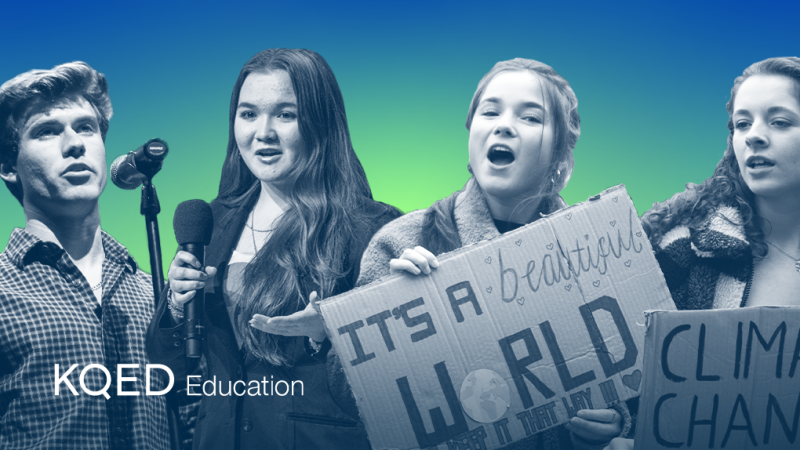This Earth Month, we bring you a collection of youth perspectives calling for reforms to protect the planet for future generations. The image, audio, and video-based projects below display Gen-Z’s passion for environmental activism—these youth insist climate change is already affecting us today, and they are inspired to find solutions to protect the planet and its biodiversity. Listen to their stories and share the ones which resonate the most with your classroom and community.
All of the pieces were written and produced using the free KQED Youth Media Challenge curriculum. Find thousands more youth voices on the Youth Media Challenge Showcase, where middle and high school students are sharing issues and topics that matter to them.
Climate Change Is Here
- Exposition by a 7-year-old: California Drought Coco hopes to catch people off-guard with the young narrator’s voice in her video as she warns people about the seriousness of California’s drought.
- Rising Sea Levels Masah, Leilah and Brenna have seen first-hand the impact global warming has on their local beaches.
- How Has Climate Change Affected California? Emilia lists just some of the ways people use excessive water and how this is connected to drought and wildfires.
- How Climate Change Affects Youth’s Mental Health Ziyuan, Isabella and Samantha highlight the traumatic impact climate change has on youth who live through environmental disasters.
The Change We Need
- The Main Problem With Electric Vehicles Jonah, Augustin, and Jose highlight the hidden environmental costs of EVs and call on the Department of Justice to explore alternative strategies to lithium batteries.
- Let’s All Help Keep Wild Animals Wild After a scary incident with his sister and a coyote, Callen became passionate about everyone taking steps to prevent animals from becoming too comfortable with humans.
- Climate Change and the Spread of Mosquito-Borne DiseasesJasmine, Jade, and Aanya use a personal example to explain how the rise in global temperatures allows dangerous diseases such as malaria to spread more quickly.
- Nuclear Improvement Alan believes nuclear energy, specifically thorium, has great potential if we can discover safer ways to use it.
- Plastic Water Bottles–What would Happen Without Them? Ella created a political cartoon in Science class to imagine how different the world would be without plastic water bottles.
Solutions To Save the Future
- Walkin’ Drivin’ Bikin’ n’ Ridin’ Ethan and Artem make a case for designing cities centered around public modes of transportation.
- Reinventing Storm Drains When Ruby and Henry learned that storm drains are a major pathway to pollution entering the ocean, they designed, built, and tested a way to stop plastic from getting through storm drains.
- Feeding the Planet: Finding Innovative Solutions for Growing our Food Anna’s science documentary warns the audience of the dangers of synthetic fertilizers and shares alternate solutions to growing food sustainably.
- Reusing Plastic Sophie’s short video shows a few ways that people can reuse items that would otherwise be considered ‘junk’.
Are you a STEM teacher?
Middle and high school STEM educators around the country are using media to enhance project-based learning and help students creatively communicate their STEM learning. As seen in the media pieces above, students thrive when their voices and choices are reflected in the classroom.
Grab the free curriculum for the Call for Change Youth Media Challenge, which empowers students to step up as advocates for causes that matter to them. Our standards alignment helps make student learning visible while practicing NGSS and CCSS skills.
See more examples of STEM projects on the Youth Media Challenge Showcase.
Teaching ELA, Digital Media, or another subject?
The Call for Change challenge works across subject areas, from health to humanities to digital art. For more examples of how media-making enhances project-based learning, see how art projects in humanities classes can help students practice communication through informed imagery. Students can also dive into personal narrative projects, uncovering family history and sharing what community means to them.
